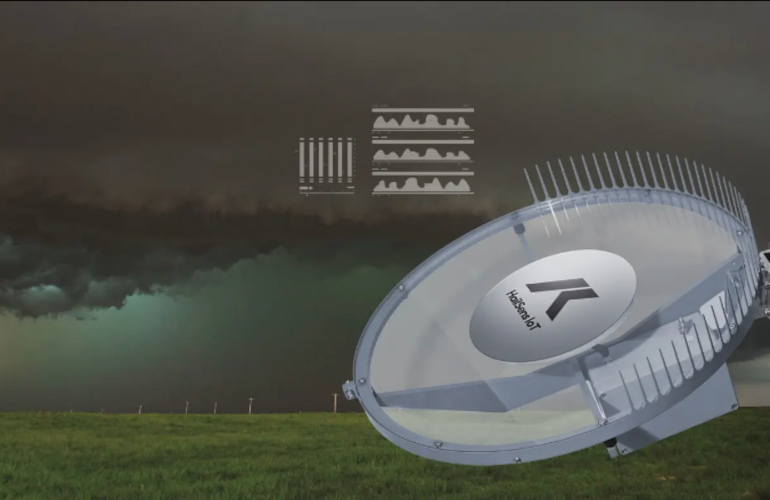KISTERS recently launched their new hail sensor, HailSens IoT. Below is a Q&A with Edgar Wetzel, Global Head of Research and Development at KISTERS, about the product and how it can be used in the solar industry.
Tell us about HailSens IoT and what makes it so special?
Edgar Wetzel: HailSens IoT is truly a revolution in hail monitoring. It is a robust system that uses a 19.7 inch (500 mm) sensing plate to detect all hail larger than 5 mm. What sets it apart is that it provides real-time data on hail size, intensity, and distribution that is simply not possible with traditional methods.
How does it work?
HailSens IoT uses piezoelectric microphones to capture the kinetic energy of hail as it hits the sensing plate. This data is processed in real-time by an integrated microcontroller that determines the kinetic energy of each hailstone. The data is instantly sent to a local system or cloud server for immediate analysis and early warning alerts.
Who will benefit most from using HailSens IoT?
HailSens IoT is incredibly versatile. Meteorologists can use it to improve weather forecasts and investigate hailstorms in detail. Operators of sensitive infrastructure like utility-scale solar power plants and large commercial buildings can find it extremely useful for damage assessment. Insurance companies can use the data to streamline claims, making the process faster and more accurate. Emergency response teams can also use real-time information to improve collaboration.
Why is hail watching so important?
Hailstorms cause significant damage every year. Between 2008 and 2019, they caused approximately $14 billion in insured losses in the United States alone. Understanding and mitigating hail damage is critical for industries such as renewable energy, building management, and agriculture. HailSens IoT gives you the accurate data you need to make informed decisions and protect your valuable assets.
What are the main benefits of using HailSens IoT?
One key advantage is the real-time warning: as soon as hail is detected, users are notified and can take protective measures, such as tilting solar panels or closing shutters. This can significantly reduce damages and costs. HailSens also provides a detailed and objective assessment of the hail situation, capturing data on hail size, kinetic energy and individual timestamps. This allows for more efficient processing of insurance claims and efficient allocation of resources during recovery.
How was HailSens IoT developed?
HailSens IoT is the result of extensive research and development. During the preliminary R&D phase, we partnered with HTW University of Applied Sciences to carry out laboratory and field tests. This initial collaboration allowed us to develop a sensor that provides accurate and reliable hail monitoring. Even in the absence of a global standard for hail measurement, HailSens IoT maintains continuity of data collection and long-term evaluation, making it invaluable for scientific research.
How does HailSens IoT benefit utility-scale solar installations in particular?
For utility-scale power plants, HailSens IoT is a unique asset. It provides real-time monitoring and actual record of hail events, detailing their size, intensity, and distribution across the solar array. This comprehensive data supports rapid damage assessments and facilitates productive, data-driven conversations with insurers. This proactive approach protects valuable assets and supports the broader goal of maintaining a reliable and sustainable energy supply.
In conclusion, why is HailSens IoT a must-have for hail monitoring?
HailSens IoT is more than just a hail detection system. It’s an essential tool for understanding and mitigating hailstorms. With advanced technology and comprehensive data capabilities, it sets a new standard in hail monitoring. As severe weather poses increasingly more challenges, solutions like HailSens IoT are essential to protect your assets and ensure a resilient future.
HailSens is the culmination of years of dedicated research. As the only hail sensor that seamlessly integrates with hail pad data, the gold standard for scientists around the world, HailSens provides continuity and accuracy in collecting hail impact data. Field-proven, HailSens provides unparalleled real-time insights, making it the first choice for both insurance claims and scientific research.
Edgar Wetzel serves as Global Head of Product Management (Measurement) at KISTERS AG, a world-renowned leader in environmental software products and services. Over a rich career spanning more than 35 years, Edgar has honed expertise in environmental monitoring, meteorology, hydrology, noise mapping and air pollution control. In his role, he spearheads innovative projects that advance sensor technology, data management software and scientific applications dedicated to increasing environmental sustainability.

